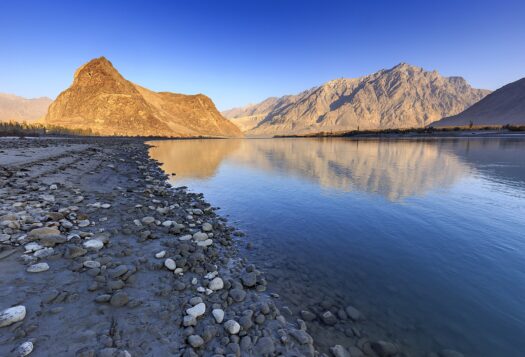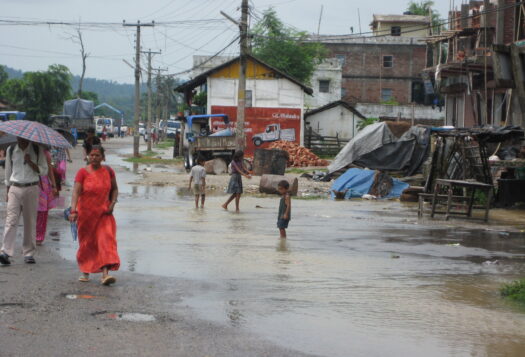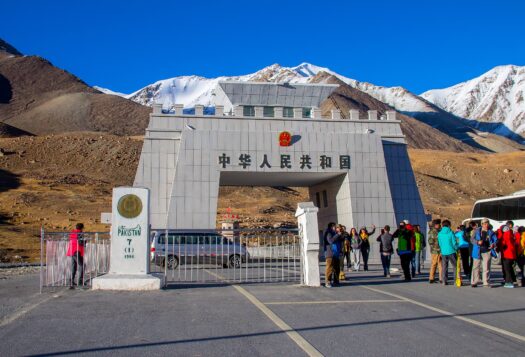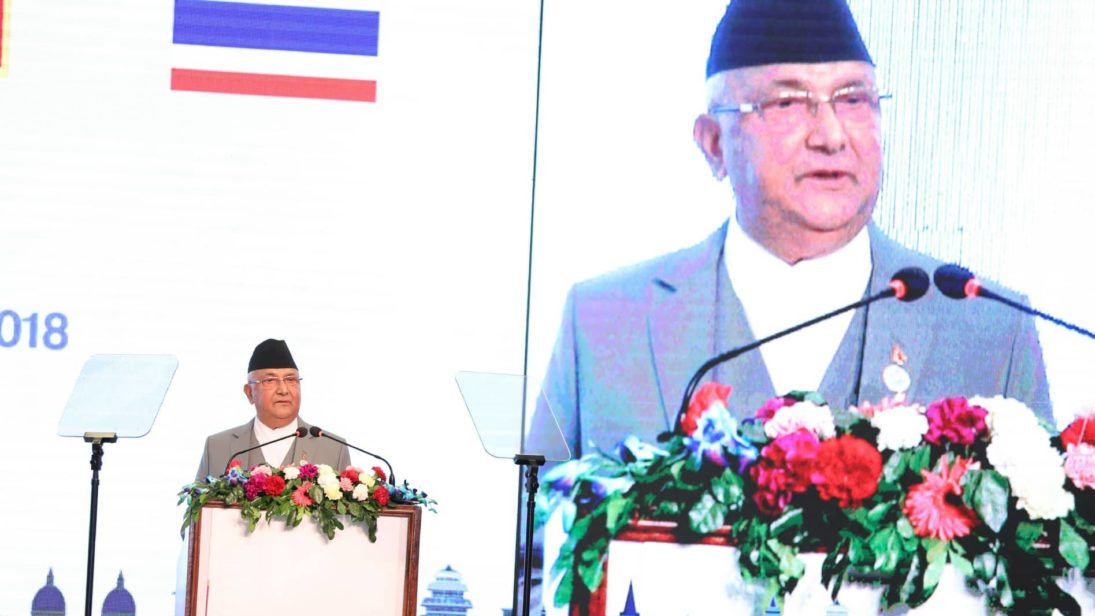
Since its landmark national elections in 2017—the first in two decades—the past two years in Nepal have been a time of newfound stability. In 2018 KP Sharma Oli was sworn in as Nepal’s 41st Prime Minister. This was followed by the unification of the two communist parties of Nepal—the Oli’s Communist Party of Nepal-Unified Marxist-Leninist (CPN-UML) and the CPN-Maoist Centre (CPN-MC)—on May 17, creating the powerful Nepal Communist Party (NCP). With a nearly two-thirds majority in Parliament, the NCP government will likely rule for five years without much opposition—which is hoped to bring security to a country that had been fraught with instability since the Maoist insurgency in 1996.
In 2019, Nepal’s recent stability contributed to economic growth and has provided the consistency necessary for more dynamic external engagement. The World Bank reported that Nepal’s growth rate reached 7.1 percent in 2019, there has also been an increase in international investment (although this is an area that could still use improvement). A greater sense of stability has also given Nepal’s government space to develop a cohesive foreign policy, which in the past year has focused on diversifying economic and diplomatic relations beyond India and China, maintaining its stance against foreign interference in internal political affairs, and making the economy central to Nepal’s foreign policy.
However, Nepal’s government still faces challenges as the country works to navigate global and regional rivalries. Several key issues will likely shape Nepal’s domestic and foreign policy in the year to come. The domestic issues range from the power-sharing within the ruling NCP to questions about Prime Minister Oli’s deteriorating health condition. The most pressing foreign policy issue is Nepal’s ability to strike a balanced approach to working with India, China, and the United States.
Several key issues will likely shape Nepal’s domestic and foreign policy in the year to come. The domestic issues range from the power-sharing within the ruling NCP to questions about Prime Minister Oli’s deteriorating health condition. The most pressing foreign policy issue is Nepal’s ability to strike a balanced approach to working with India, China, and the United States.
Government Stability
Although there appears to be continued support for the NCP, as a new party there are still risks of destabilization, particularly if the power-sharing agreement between the CPN-UML and the CPN-MC does not hold. If there are splits inside the ruling parties due to disputes over power sharing, Nepal’s leading political parties will once again be focused on coalition building with Nepal’s many parties—which in the past resulted in significant deadlock that kept the country from conducting effective foreign and domestic policy.
Maintaining the power-sharing deal signed by Oli and Co-Chairman Pushpa Kamal Dahal (leader of CPN-Maoist Centre) in 2018 continued to dominate national politics this year and will likely remain a top political issues of 2020 as well. As per the agreement, Oli will have to hand over either party leadership or premiership within 2.5 years of government formation, which is mid-2020. If this arrangement perseveres, the current government will last five years, although it is uncertain whether it will be sustainable. During the third week of November, for instance, Oli officially gave Dahal executive rights and the role of executive chairman, but later claimed he too held such rights as the “senior executive chairman.” This move has created a climate of mistrust between the two leaders and others competing for power. For example, another senior leader of NPU, former Prime Minister Madhav Kumar Nepal, is vying for both party presidency and prime minister.
At the same time, the health condition of Prime Minister Oli remains a prominent issue in Nepal’s domestic affairs. Oli has traveled twice to Singapore for reported kidney issues, and his potential deteriorating health condition may make him less active in governance, forcing him to gradually relinquish responsibilities to other leaders, which may impact the government’s stability.
In addition to Oli’s suffering health and concerns over internal rifts, the government has faced criticism for ongoing domestic issues, such as its inability to prevent a brain drain as skilled Nepali youth move abroad for employment. Despite having a strong government, the NCP has also been criticized for failing to control corruption or speed up infrastructure projects. Several roads and infrastructure projects have failed to make a headway and performance of government will be measured through its capacity to deliver on much needed infrastructure projects.
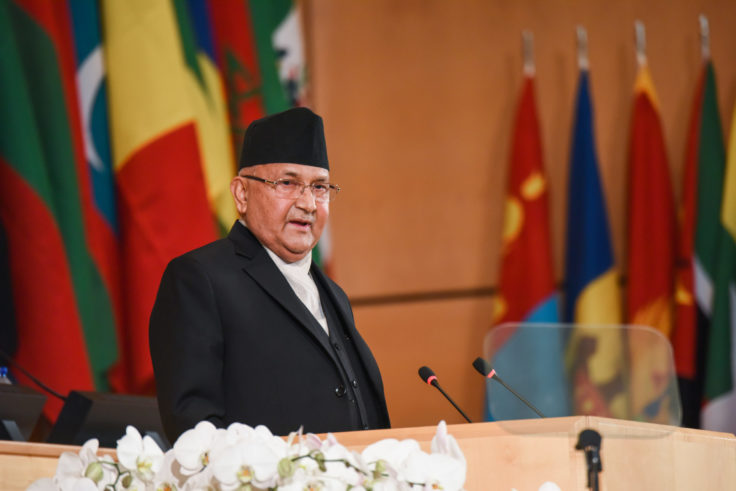
“Amity with all, Enmity with None”: Nepal’s 2019 Foreign Policy
The Oli-led government has taken some steps to reform the country’s foreign policy, which was victim to political instability and politicization during the last two decades. With the slogan, “Amity with all, enmity with none,” the government has taken measures to diversify its economic and foreign policy options, with hopes of ending the past tradition of its international engagement being mostly limited to India and China.
Concurrently, the government is very cautious of appearing to favor any country, like it has done with India in the past. However, there are perceptions in India and Western countries that the new Communist government is tilted towards Beijing. This perception stems from the broad ideological alignment of the two governments, but has also been bolstered by the Oli government’s focus on bringing more Chinese investment and efforts to give Nepal access to Chinese roads and ports, in order to increase trade and rely less on India for transit.
While much attention has been paid to stronger ties with Beijing, Nepal has begun to build stronger diplomatic relations with countries beyond its immediate neighbors. For example, official engagement of foreign ministers has resumed with traditional powers such as Japan, Russia, and Germany. Nepal has also been more involved in regional and international diplomatic platforms. For instance, in January 2019, Prime Minister Oli became the first Nepali leader to attend a World Economic Forum meeting which was held this year in Davos, Switzerland. For Nepal, the key agenda of these enhanced diplomatic relations is economic diplomacy.
Keeping up the Balancing Act
In 2019, Nepal faced new challenges to its foreign policy as it balanced between major powers including China, India, and the United States. In June of 2019, the United States revealed its Indo-Pacific Strategy, which has been perceived as a counter strategy to China’s Belt and Road Initiative (BRI). Tensions between the Indo-Pacific Strategy and BRI remain a core subject of debate in Nepal’s foreign policy. Despite potential military cooperation and U.S. diplomatic efforts to bolster ties with Nepal—including a visit to the region in 2019—Nepal has been skeptical of what it views as efforts to pull it away from China. Hinting at the Indo-Pacific Strategy, Foreign Minister Pradeep Gyewali and Defense Minister Ishwar Pokhrel have repeatedly stated that Nepal would not join any military alliance. As Nepal is pursuing the policy of non-alignment, joining any military alliance would be against its stated policy. However, outright rejection of the U.S. Indo-Pacific strategy risks hurting Nepal’s broader strategy of economic diplomacy—with U.S. officials warning that Nepal pulling away from the U.S. could cost it economic opportunities.
Tensions between the Indo-Pacific Strategy and BRI remain a core subject of debate in Nepal’s foreign policy. Despite potential military cooperation and U.S. diplomatic efforts to bolster ties with Nepal—including a visit to the region in 2019—Nepal has been skeptical of what it views as efforts to pull it away from China.
To further complicate Nepal’s balancing act, China has indicated a clear interest in maintaining strong ties with Nepal. This year, Chinese President Xi Jinping became the first Chinese president to visit Nepal in 23 years. During his visit, Nepal and China signed 20 agreements on infrastructure and investment projects. However, while politicians have been cautious about aligning too strongly with the Indo-Pacific strategy, some have also expressed concerns over aligning too much with China. For instance, Nepal has thus far resisted pressure to sign an extradition treaty with China, which human rights groups and the United States have warned would be used to target Tibetans living in Nepal.
As Nepal seeks to diversify its economic partners and moves towards greater cooperation with China, its relations with India continue to sour. India remains Nepal’s top trading partner and has cooperated with Nepal on infrastructure initiatives such as the Nepal-India pipeline project (which came into operation in September). From India’s side, there seems to be minimal effort in revitalizing relations with Kathmandu. For instance, Nepal continues to be frustrated by the lack of response to the economic pain caused by India’s demonetization of high-value rupee notes two-years-ago.
Another main issue in India-Nepal relations in 2019 was India’s release of a new political map that included Kalapani, a tri-junction between Nepal, India, and China, as part of Indian territory. India’s inclusion of the 13.5 square mile area in its territory drew protests on social media, and statements from both countries that Kalapani was recognized as part of their territory. India has thus far not responded to Nepal’s request to open a diplomatic channel to discuss the issue.
The Year Ahead
Maintaining political stability remains a major challenge for Nepal in 2020. This stability is closely linked with attracting foreign investment in order to meet Nepal’s growing development needs. Any differences between Oli and Dahal may place Nepal’s long-sought-after political stability in peril. The current stability has allowed the government to pursue greater foreign investment—for instance through the investment summit held in March of this year—but any new political insecurity could threaten future economic development. To meet the aspirations of graduating to a middle-income country by 2030, Nepal has to substantially grow its economy. This calls for significantly more foreign direct investment in the next 10 years. For this to happen, the government needs to pay more attention to investment obstacles including lack of transparency, inefficiency, and cumbersome bureaucratic delays.
On the foreign policy front, Nepal’s government has the monumental task of striking a balanced approach among three major powers—India, China, and the United States—who are, of late, competing more to increase their influence in Nepal. At the same time, Nepal can continuously engage with its major and traditional development partners such as Japan, United Kingdom, and Australia. However, if the Oli government aspires to diversify Nepal’s foreign partners, it will need to maintain domestic stability first.
Editor’s Note: SAV contributors from across the subcontinent recap the most significant political, economic, and strategic developments in South Asia in 2019 and analyze what opportunities and challenges lie ahead for each country in 2020. Read the full series here.
***
Image 1: KP Sharma Oli via Twitter
